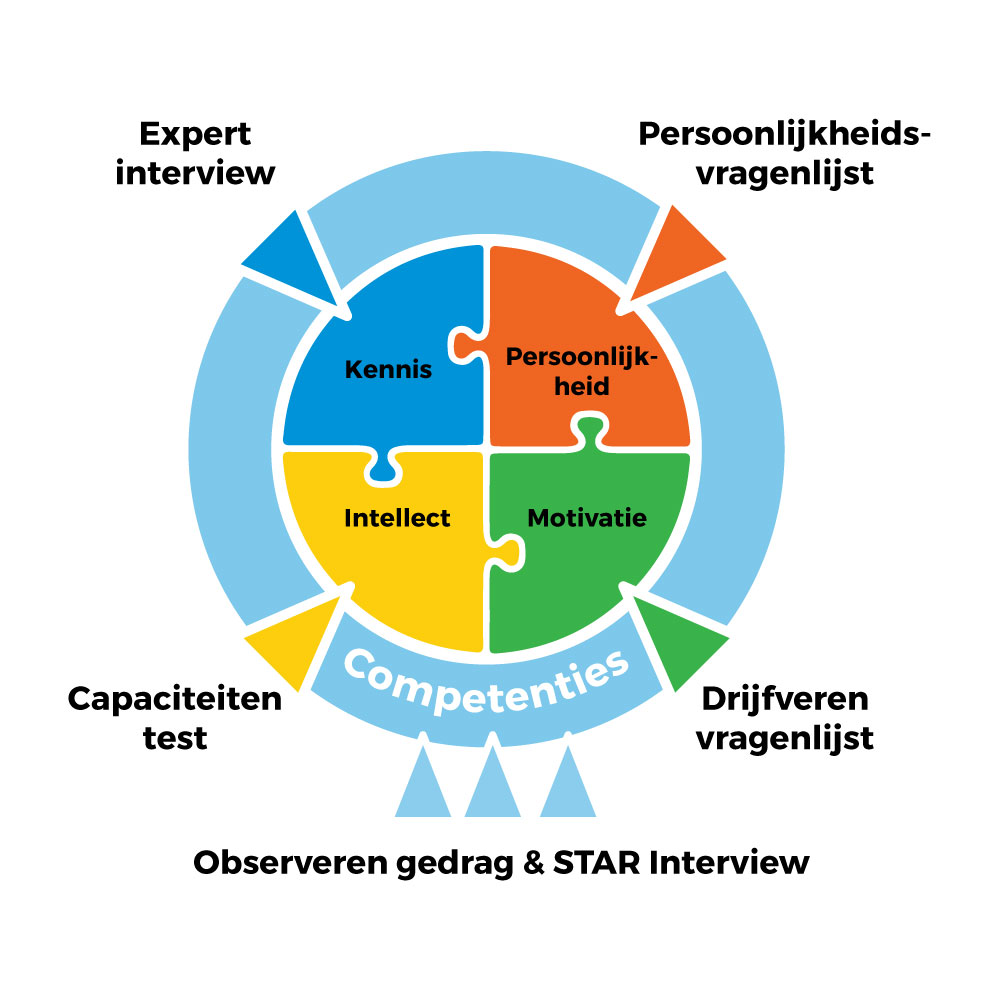When selecting and developing talent, it is crucial to understand both personality traits and competencies. Personality questionnaires are used to gain insight into character traits, with often the implicit assumption that these traits translate directly into mastery of competencies. But does a high score on a personality trait automatically mean that your candidate possesses the corresponding competency? The answer is more complex than a simple yes or no.
In this article, we explore personality traits, how they relate to competencies, and why a high score on a personality trait does not necessarily mean a candidate possesses the corresponding competency.
A personality trait is a relatively stable characteristic that describes how a person tends to behave. Traits like “persuasive,” “analytical,” or “planful” Are examples. While these traits can be a useful predictor of behavior, it’s important to remember that they don’t provide a complete picture of a person’s performance in the workplace.
Competencies are measurable behaviors or skills demonstrated in a specific context. A personality trait describes the tendency, but competencies revolve around what a person can really demonstrate. Competencies can be understood as concrete, successful, observable behaviors. The difference between personality traits and competencies is that competencies can be trained and developed, while personality traits are less changeable.

A common misconception is that a high score on a personality trait automatically means someone has the corresponding competency, especially since many personality traits have almost the same naming as competencies. Consider the personality trait analytical vs. the competency problem analysis or planned (personality trait) vs. planned/structured work.
However, as psychological scientific literature substantiates, personality traits are only one factor contributing to competent behavior.
Let’s consider the personality trait “persuasive”. Suppose a person scores high on this trait. This person loves to negotiate, likes to influence others, and is focused on gaining support from others. But is this person also competent in “persuasive action”?
The competency of “persuasive action” is influencing people and situations, communicating ideas firmly and clearly to gain acceptance, and overcoming resistance. Although the personality trait “persuasive” can provide a basis for this competency, it is not sufficient to judge it solely on this. Personality is the tendency to exhibit a certain type of behavior, while competence is the mastery of a certain set of behaviors. Thus, it is about preferred behavior versus mastery/competence.
In addition to “persuasive”, several other personality traits play a role in the competency “persuasive” performance. These include:
In addition to the influence of other personality traits, cognitive levels, drives, and frustration tolerance also play significant roles.
Cognitive level
The cognitive level refers to a person’s intellectual abilities, such as analytical thinking, problem-solving skills, and processing of complex information. When communicating ideas persuasively, a person must possess the right personality traits and the cognitive abilities to present arguments logically and structured. The cognitive level required is, of course, highly dependent on the issue’s complexity. Experiential knowledge also plays an explicit role here.
Drives
Drives are the internal motivation that drives a person’s behavior. For example, your candidate may score high on the attribute “persuasive”, but if that candidate has a strong need for security and harmony, the internal motivation to go against consensus will be lacking, which may limit the competency of persuasive action in some situations. Drives guide behavior and are also a component in determining competency.
Frustration tolerance
Finally, frustration tolerance is also an aspect of effective persuasion. Persuasion often involves resistance. The degree to which a person can persevere despite setbacks, criticism, or rejection helps determine their effectiveness in persuasion. Frustration tolerance ensures that a person does not give up easily and persists until the message has been delivered. In our assessment practice, for example, we see low frustration tolerance emerge as a strong risk factor in sales positions.
The difference between personality traits and competencies is critical to the successful selection and development of talent. An interplay of various personality traits, cognitive abilities, motivations, tolerance for frustration, and accumulated experience forms competencies. Whereas personality traits provide insight into an individual’s behavioral tendencies, competencies are the concrete behaviors a person demonstrates in practice.
When judging competencies, HR management should look beyond just the results of a personality questionnaire. By including a combination of personality traits, cognitive abilities, motivations, and experiences, HR professionals can form a more complete picture of a candidate or employee’s potential. With better insights, better decisions can be made about hiring, training, and future career directions.
Or call: +31 88 – 277 377 6
To call directly: +31 88 277 377 6